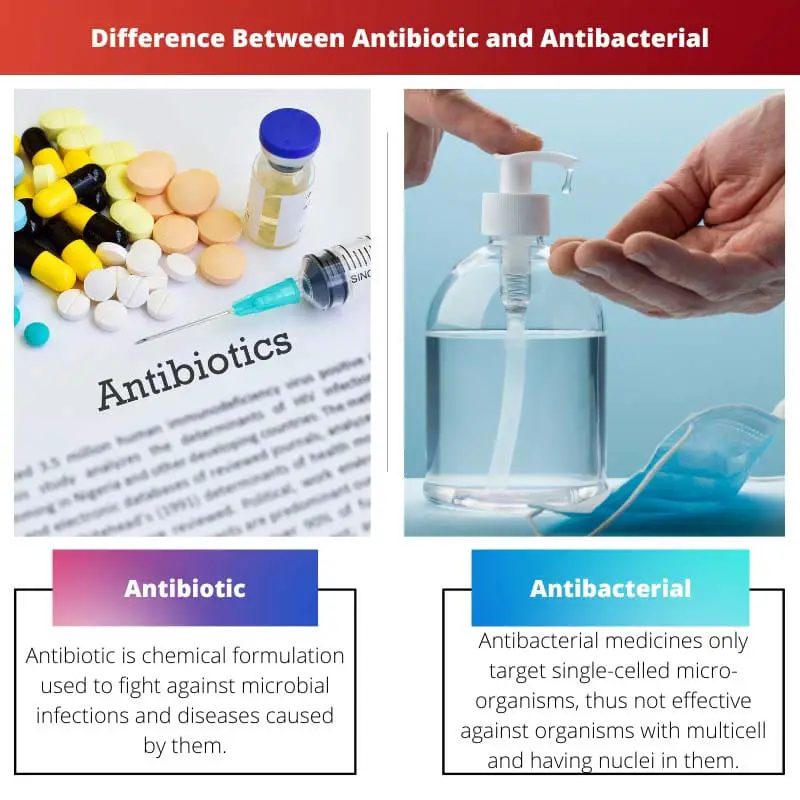Medicines are the cure for a disease and can be in the form of a tablet, syrup, injection, or any type of cream, etc. The doctors prescribe these medicines, and it includes time table within which you have to intake that medicine.
Intaking the wrong medicines or taking them excess can cause harmful side effects; therefore, one should limit the intake of drugs.
Antibiotics and Antibacterial medicines come in the bacterial treatment medicines or drugs category. Both these medicines work inside as well as outside the body.
For internal treatments, it comes in pills, syrup, or injections, whereas for external treatment, it comes in the form of lotion, gel, etc.
Key Takeaways
- Antibiotics are medications used to treat bacterial infections, while antibacterials refer to substances or products that inhibit or kill bacteria.
- Antibiotics are specific to medical treatments and prescription drugs, whereas antibacterial products can be found in everyday items like soaps and cleaners.
- Antibiotics target bacterial cells internally, whereas antibacterial products act externally to prevent the growth or spread of bacteria.
Antibiotic vs Antibacterial
Antibiotics are a class of drugs that are used to treat bacterial infections. They work by either killing the bacteria or stopping their growth and are used to treat a wide range of conditions. Antibacterials can kill the growth of bacteria, regardless of whether it is a drug or not.

Antibiotic comes under the antimicrobial drug category. These drugs inhibit or prevent the growth of bacterial or microbial cells inside the body.
Antibiotics are also helpful in treating infections caused by protozoa like malaria, cryptosporidiosis, toxoplasmosis, African sleeping sickness, etc.
Antibacterial comes under the category of Antibiotics that only targets bacterial infections. These medicines originate from an organic or biological source but can also be manufactured with chemicals artificially.
Antibacterial drugs kill the bacterial growth inside as well as outside the body.
Comparison Table
| Parameters of Comparison | Antibiotic | Antibacterial |
|---|---|---|
| Target microbes | Antibacterial drugs do not target a variety of microbes like Antibiotic drugs instead, it only focuses on Bacteria. | This medicine focuses on areas like the cell wall that includes peptidoglycan, DNA of bacteria, and metabolism. |
| Target cell | This type of drug targets only procaryotes and eucaryotes call types. | This drug targets organisms with one cell and no nucleus and is called prokaryotic cells. |
| Areas focused | This medicine focuses on areas like glucan, fungal cell, and cell wall that includes peptidoglycan, DNA of bacteria, metabolism, etc. | Antibiotics are seen in capsules, pills, or through intravenous medical techniques. |
| Usual form | The side effects of this drug include vomiting, diarrhoea, bloating, pain in the abdominal area, etc. | Antibacterial drugs are seen in the form of disinfectants, bathing soaps, tablets and cleansing products, etc. |
| Aftereffects or Side effects | This drug’s side effects include rashes, dizziness, infections caused by yeast, etc. | The side effect of this drug includes rashes, dizziness, infections caused by yeast, etc. |
What is Antibiotic?
An antibiotic is a chemical formulation used to fight against microbial infections and diseases caused by them. This medicine targets the DNA or bacterial cell directly and inhibits its further growth in a specific organ.
These drugs can be synthesized in a laboratory or generated through living organisms like fungi and bacteria.
Antibiotics are made by observing living organisms’ natural way of fighting off bacterial or fungal infections. Antibiotics are classified into various categories depending on the micro they kill.
For example, if an Antibiotic targets bacteria, it is named an Antibacterial drug. Similarly, if an Antibiotic targets fungal infections, it is called an Antifungal.
Antibiotics should be taken with the prescription of the doctors only because they can cause severe side effects and may become the reason for other bacterial infections.
And also, the course prescribed for Antibiotics should be completed fully because, if not done correctly can cause future bacterial development in the body.

What is Antibacterial?
Antibacterial medicines only target single-celled micro-organisms, thus ineffective against organisms with multicell and nuclei.
These medicines are also produced from living organisms and can be made synthetically in the laboratory using chemicals.
Antibacterial medicines are categorized into two types one is bacteriocidal, and another is bacteriostatic.
The bacteriocidal is used for killing the bacteria or eradicating the bacterial cell,. In contrast, the bacteriostatic is only used to inhibit the growth of the bacterial cell or the affected cell.
Antibacterial medicines and drugs are less harmful to human beings when compared with Antibiotics. Still, overuse of them can weaken our immune systems, which exposes us to harmful microbes.

Main Differences Between Antibiotic and Antibacterial
- Antibiotics are medications used to cure infections caused by microbes like fungi, algae, bacteria, protozoa, and specific types of viruses. On the other hand, Antibacterial drugs do not target a variety of microbes like Antibiotic drugs do. Instead, it only focuses on Bacteria.
- Antibacterial drugs are seen in the form of disinfectants, bathing soaps, tablets and cleansing products, etc. Whereas, Antibiotics are seen in the form of capsules, pills, or through intravenous medical techniques.
- Antibacterial drug targets organisms with one cell called prokaryotic cells. While the Antibiotic drug targets only procaryotes and eucaryotes, call types.
- Antibiotic medicine focuses on areas like the cell wall, including peptidoglycan, bacteria DNA, and metabolism. Antibacterial medicines focus on areas like glucan, fungal cells, and cell walls, including peptidoglycan, bacteria DNA, metabolism, etc.
- Antibiotic aftereffects include vomiting, diarrhoea, bloating, pain in the abdominal area, etc. At the same time, the aftereffects of Antibacterial drugs include rashes, dizziness, infections caused by yeast, etc.





